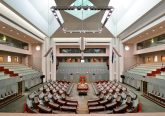On 14 July, following legal proceedings, the National Archives of Australia released correspondence between Sir John Kerr, who served as Governor General of Australia from 1974–77, and Sir Martin Charteris, the Principal Private Secretary (PPS) to the queen. The letters concern Kerr’s decision to dismiss Gough Whitlam, the Labor Prime Minister, who was then locked in a battle between the House of Representatives, where he held a majority, and the Senate, which opposed him and was blocking supply (the federal budget).
Leading scholars, such as Anne Twomey, as well as Buckingham Palace, have argued that the letters contain no smoking gun connecting Kerr’s actions to the monarch or her PPS. However, we believe that we can see a wisp of smoke. And it lingered. Kerr and Charteris tried to absolve the queen of any air of participation, including through Kerr’s statement, “I decided to take the step I took because under the Constitution the responsibility is mine and I was of the opinion that it was better for Her Majesty not to know in advance …” (Kerr to Charteris 11.11.1975). Charteris replied, “I believe that in NOT informing The Queen what you intended to do before doing it, you acted not only with perfect constitutional propriety but also with admirable consideration of Her Majesty’s position” (Charteris to Kerr 17.11.1975). A closer examination of the exchange between these two individuals, however, reflects Charteris’ subtle hints to the Governor General about the Palace’s position.
Brutally labelled “irresponsible advisors” by the UK constitutional lawyer Ivor Jennings (Jennings 1959: 343), the PPSs’ role is “to guard the constitutional position of the sovereign” (Bogdanor 1995: 201). However, the sovereign’s discretionary powers, including dismissal of a prime minister, are not clearly defined, and an overactive PPS can endanger the constitutional position just as easily as guard it, as we discuss below. Moreover, as Jennings points out, PPSs’ views are “necessarily … clouded with personal bias. They [are] nearly all military officers. Several of them [have been] closely related. Occasionally their personal views have been allowed to appear” (Jennings 1959: 344).
The Australian crisis arose when the Senate blocked supply in 1975. The bicameral Australian legislature includes a House of Representatives, which is apportioned by population, and a Senate, which includes two members from each state or territory. The prime minister sits in the House, but membership in the Senate favours less populous states and may have a different partisan composition. In 1975, the Australian Labor Party controlled the House of Representatives, but there was a deadlock in the Senate. When a vacancy opened up, Queensland’s premier did not comply with convention and appoint a replacement Senator from the Labor Party, which had held the seat. Instead, he appointed a renegade Labor member who did not support Whitlam, the Prime Minister, but who also turned out not to be able to serve immediately. This created a one-seat majority for the Liberal-Country Party Coalition. The coalition, led by the Liberal Malcolm Fraser, deferred supply on October 16–17 to force an early election. Whitlam responded by playing chicken: he wanted to avoid an election and thought Fraser would give in before supply ran out on 30 November (Whitlam 1979: 72)
In September, with potential rejection of supply in the air, Governor General Kerr recounted to PPS Charteris that he and Whitlam had discussed whether Whitlam might present the budget to Kerr without Senate approval, on the theory that the Senate lacked power under the constitution to reject it (Kerr to Charteris 20.09.1975). He also wrote that he had discussed the matter with Sir Garfield Barwick, the Chief Justice of Australia, who had said that the need for Senate consent to the budget was clear. Kerr’s second letter the same day informed Charteris that Kerr had had “interesting talks” with Prince Charles, who was visiting Australia at the time, and in his response, Charteris informed Kerr that on his return Charles had “enlarged to The Queen on the problems [Kerr was] facing as a result of [Charles’] talks with [Kerr]” (Charteris to Kerr 24.09.1975). Charteris writes, in his own hand, at the foot of the letter:
“I suppose you know Eugene Forsey’s book “The Prerogative of the Dissolution”? [sic] I believe he lays it down as a principal [sic] that if supply is refused that always makes it constitutionally proper to grant a dissolution.”
The book Charteris refers to, The Royal Power of Dissolution of Parliament in the British Commonwealth, is one of the only legal defences of the conduct of the Canadian Governor General, Lord Byng of Vimy, during a similar crisis. In 1926, Byng rejected a request for a dissolution from his Liberal Prime Minister, Mackenzie King. King resigned, and his successor, the Conservative Arthur Meighen, was defeated in a matter of days in a non-confidence vote. Meighen lost the ensuing election, which he requested but which had been denied to King. Thus, Byng denied a dissolution to King, who resigned, but shortly after granted one to the opposition, implicitly showing a bias in favour of the Conservatives, who could campaign as incumbents. Following Meighen’s loss, the Liberals governed Canada until 1930, and Byng returned to London in disgrace. The King/Byng affair is generally considered a cautionary tale (Keith 1928: 106, n. 1; Evatt 1936: 64).
Charteris’ next letter (02.10.75) offers comments on the Australian Constitution, which to Charteris’ “untutored eye” appeared to permit the Senate to refuse supply—agreeing with Barwick. Charteris wrote that Prince Charles had conveyed Kerr’s concern that Whitlam might ask for Kerr to be recalled in order to avoid his own dismissal. Charteris reported:
“If such an approach was made, you may be sure that The Queen would take most unkindly to it. There would be considerable comings and goings, but I think it is right that I should make the point that at the end of the road The Queen, as a Constitutional Sovereign, would have no option but to follow the advice of her Prime Minister [i.e. Whitlam].”
While the latter part of the message was clear, “comings and goings” offered some hope of delay, and the certainty of the queen’s “unkindly” reaction could have influenced Kerr’s judgement.
Kerr dismissed Whitlam on 11 November 1975, the Senate approved supply that afternoon, and Kerr dissolved parliament immediately afterward. Kerr’s disgrace was not as immediate as Byng’s had been, as Fraser, the Liberal leader, won the subsequent election and governed until 1983. However, Kerr largely withdrew from public life, and he agreed to resign in 1977, having initially intended to remain in post until 1984. He was encouraged to retire by the Palace, and meeting notes reflect the Palace’s concern that Kerr might publish his correspondence with Charteris once he was out of office (Kelly and Bramston 2015).
Charteris did not know exactly what Kerr was planning to do, nor when he would do it. And he certainly did not instruct Kerr to dismiss Whitlam. However, in an environment without clear rules, Charteris’ bias was clear from his correspondence, and based on the correspondence, Kerr almost certainly believed that he understood where Charteris and the queen stood (Kelly and Bramston 2015, citing Kerr Journal for 1980, National Archives of Australia). The gun may not look like it’s smoking from far away, but up close the odour of gun powder was likely quite pungent.
The full article on which this post is based is currently a Nuffield Working Paper. Comments are welcome.




